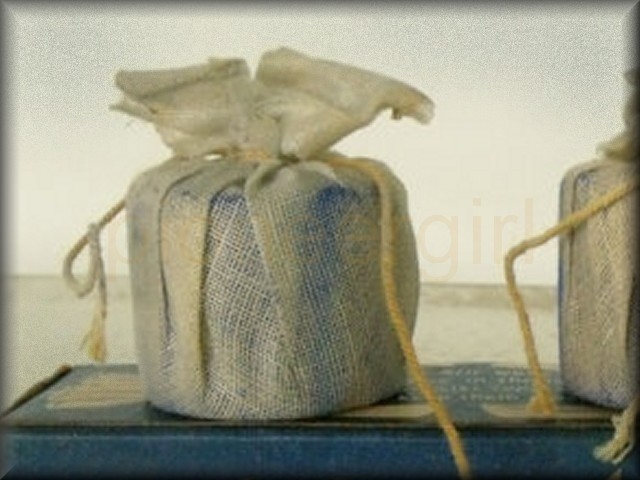blueing bag

blueing. Something to give a bluish tint, as indigo used by washerwomen. — Webster, 1882
 The owner of a small (paper) mill went to sell his product, leaving his wife at home. It was washing day – presumably Monday – and the good wife had a blueing-bag tied to her apron. She visited the mill, and leaning over the engine, dropped her blueing-bag, and instead of white paper she had a lot of blue paper. She met her husband upon his return… and informed him of the misfortune. He felt as if a very serious mistake had been made until he sent the product to market and received five cents per pound more than for his usual article, and thereafter his mill was run on blue paper and it brought him a fortune. – The American Stationer, February 18, 1886
The owner of a small (paper) mill went to sell his product, leaving his wife at home. It was washing day – presumably Monday – and the good wife had a blueing-bag tied to her apron. She visited the mill, and leaning over the engine, dropped her blueing-bag, and instead of white paper she had a lot of blue paper. She met her husband upon his return… and informed him of the misfortune. He felt as if a very serious mistake had been made until he sent the product to market and received five cents per pound more than for his usual article, and thereafter his mill was run on blue paper and it brought him a fortune. – The American Stationer, February 18, 1886
 One of the ways that white clothing and linens were made to appear “whiter” was to rinse them in water tinted blue, so that the white wash took on a pearly-blue color. This blue color masked yellowing of white fabric and made it appear “brighter.” During the time of the Little House books, laundry blueing (or bluing) would have been made of indigo, Prussian blue, or ultramarine dye.
One of the ways that white clothing and linens were made to appear “whiter” was to rinse them in water tinted blue, so that the white wash took on a pearly-blue color. This blue color masked yellowing of white fabric and made it appear “brighter.” During the time of the Little House books, laundry blueing (or bluing) would have been made of indigo, Prussian blue, or ultramarine dye.
The dye would stain the fingers blue if handled, so it was most often kept sewed or tied in cloth parcels or bags, which were swished into the hot rinse water until the desired tint was reached. The bag was then placed in its own box or dish to air-dry until next laundry day. Blueing bags were sold commercially or could be made at home. The advertisement shown here is from the March 26, 1881, (Chicago, Illinois) Daily Inter Ocean, a newspaper mentioned in the Little House books. Laura Ingalls Wilder mentions the use of a blueing bag in The Long Winter; perhaps the advertised product was the one Ma used! Blueing was also sold as a liquid, and is still in use today. Navigation button image of a blueing bag is from Kathy Thomas, used with permission.
The following guide instructed the novice in the use of a blueing bag:
The indigo bag for blueing the rinsing water should be made of new white flannel. The usual form is square, sewed all around at the edges, leaving a small opening at the top to put in the indigo; which opening must always be sewed up after replenishing the bag with a fresh supply. When you use it, hold the bag in the water, pressing it with your fingers till you have squeezed out sufficient blue to give a very light tinge. Then paddle your hand through the water to diffuse the color equally. — Miss Leslie, The House Book: or, A Manual of Domestic Economy for Town and Country (Philadelphia: Carey & Hart, 1844), 10-11.
The October 10, 1868 issue of Harper’s Bazaar magazine (page 789) gave instructions for making a blueing bag, a starch bag (for adding starch to the rinse water), and a wax bag (ironing over it with a hot iron would removed traces of starch left on the iron). Not merely a utilitarian piece of flannel as described above, this blueing bag was to be made from a 7-inch circle of flannel, hemmed and edged with lace! A piece of insertion lace sewn around the outer edge served as the casing for a drawstring. The illustration below accompanied the instructions.


blueing bag (TLW 18)

